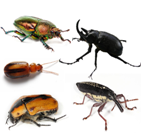
Interactions
Molluscs can be incredibly small compared to other organisms on Earth, so naturally they have some predators. Mice and shrews can chew through the tops of the shells in order to acquire its food (Dourson, 2006). Some beetles that are smaller are able to enter the aperture to remove it (Dourson, 2006). Salamanders can also be a predator to Molluscs. One may find that molluscs also face predation by rats, moles, badgers, toads, frogs, crabs, turtles, ants, and humans (Welcome Wildlife.com, 2012).
There are even predation interactions between the snails themselves.
As young snails hatch, they feed on their own shell as well as the
shells of other snails for nutrients (Welcome Wildlife.com, 2012).
The shell may even still have a snail inside while the hatched snail
feeds on it (Welcome Wildlife.com, 20112).
A snail is considered to be a primary consumer in the food web (BBC, 2012). While the snails eat producers (BBC, 2012).
To find more information go to the Facts tab and read up on our random facts about the Daedalochila chisosensis.
